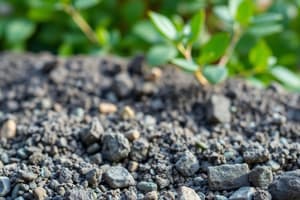Podcast
Questions and Answers
Which of the following sources is considered non-renewable and forms at a slower rate than it is consumed?
Which of the following sources is considered non-renewable and forms at a slower rate than it is consumed?
- Solar Energy
- Wind Energy
- Geothermal Energy
- Fossil Fuels (correct)
Which of these is NOT a source of energy that forms slowly?
Which of these is NOT a source of energy that forms slowly?
- Coal
- Nuclear Energy
- Hydropower (correct)
- Natural Gas
What is a characteristic of fossil fuels and nuclear energy?
What is a characteristic of fossil fuels and nuclear energy?
- They form at a much slower rate than they are consumed. (correct)
- They are renewable sources.
- They are derived from solar power.
- They are quickly replenished.
Which energy source is classified as non-renewable with a slower formation rate?
Which energy source is classified as non-renewable with a slower formation rate?
What does the term 'non-renewable' imply about a resource like fossil fuels?
What does the term 'non-renewable' imply about a resource like fossil fuels?
Flashcards
Renewable Energy Source
Renewable Energy Source
A source of energy that can be replenished at a rate faster than it's consumed.
Non-renewable Energy Source
Non-renewable Energy Source
A source of energy that is consumed at a much faster rate than it is formed.
Fossil Fuels
Fossil Fuels
Non-renewable energy sources formed from ancient plants and animals.
Nuclear Energy
Nuclear Energy
Signup and view all the flashcards
Coal, Oil, Natural Gas
Coal, Oil, Natural Gas
Signup and view all the flashcards
Study Notes
Unit 5: Energy Resources
- Unit 5 covers mineral, non-renewable, and renewable energy resources.
Lesson 1: Mineral Resources
- This lesson is not detailed in the provided information.
Lesson 2: Nonrenewable Energy Resources
- Objectives include identifying and describing non-renewable energy resources, and explaining the impact of fossil fuels on the environment.
- Nonrenewable resources form at a rate much slower than they are consumed.
- Fossil fuels include coal, oil, and natural gas.
- Nuclear energy is also a nonrenewable resource.
Lesson 3: Renewable Energy Resources
- This lesson is not detailed in the provided information.
Lesson Objectives
- Students should be able to identify and describe non-renewable energy resources.
- Students should be able to describe the environmental impact of fossil fuels.
Fossil Fuels
- Fossil fuels are energy sources derived from biological materials.
- Fossil fuels are composed of hydrocarbons.
- Fossil fuels include coal, oil, and natural gas.
Coal
- Coal is a combustible, black or brownish-black sedimentary rock.
- Coal typically occurs in rock strata as layers or veins called coal beds or coal seams.
- Coal formation, called coalification, was most favorable 360 to 290 million years ago during the Carboniferous Period.
- Coal formation begins with a swamp on the edge of a sedimentary basin (e.g., lagoon or lake), where plant debris accumulates.
- This debris is buried under layers of mud and sand, initiating a process called sedimentation.
- Over time, the plant debris gets covered and decomposition is slowed.
- Continuous sedimentation and heat from the Earth gradually transform the plant debris into coal.
- The pressure and temperature during coalification affect the rate of conversion and the quality of the resulting coal.
- Different types of coal exist. Peat, Lignite, Sub-bituminous coal, Bituminous coal, and Anthracite, differ in moisture content and carbon content.
Oil and Natural Gas
- Oil and natural gas are both liquid and gaseous fossil fuels respectively, composed of hydrocarbons.
- Oil and natural gas formation shares similarities in its process.
- When a living organism dies, it's usually recycled by predators or decomposes.
- A small proportion of dead organisms sinks to the ocean or lake floor.
- Over time, this mixture accumulates and hardens into a source rock, which is transformed into kerogen (an intermediate material of oil) as the sediment piles up and increases in temperature and pressure.
- At a specific depth and temperature, kerogen begins to release oil.
- Further temperature increase turns the oil into gas.
- Hydrocarbons accumulate in large quantities in porous and permeable reservoir rock.
Nuclear Energy
- Nuclear energy is a method of using the energy released from nuclear fission to generate electricity.
- This process involves splitting atoms to generate heat, which boils water to produce steam for turbines.
Studying That Suits You
Use AI to generate personalized quizzes and flashcards to suit your learning preferences.




